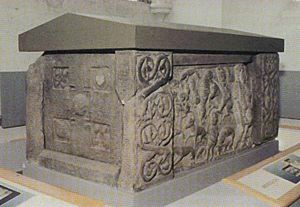Nechtan mac Der-Ilei facts for kids
Nechtan son of Der-Ilei (Old Irish: Nechtan mac Derilei), also known as Nechtan son of Dargart (Old Irish: Nechtan mac Dargarto), was a powerful king of the Picts. He ruled from 706 to 724 and again from 728 to 729. Nechtan took the throne after his brother, Bridei, in 706. He is well-known for making important changes to religious practices in Pictland. In 724, he gave up his crown to become a monk, letting his nephew take over. However, in 728 and 729, he became involved in a big fight with other leaders for control of the Pictish throne.
Contents
Who Was King Nechtan?
Historians believe that Nechtan son of Der-Ilei was the same person as Nechtan son of Dargart. His father, Dargart mac Finguine, was from a powerful family in Dál Riata. Nechtan's mother was likely Der-Ilei. The Picts sometimes allowed succession through the mother's family, which might explain Nechtan's claim to the throne.
Nechtan had several brothers and half-brothers. These included Ciniod, who died in 713, and Talorcan son of Drestan. Talorcan was a king in Atholl and was held captive by Nechtan. He was later executed in 739. Another possible relative was Congas son of Dar Gart, who died in 712.
During Nechtan's time, relations between the Picts and their southern neighbors, Northumbria, were generally peaceful. However, records show a Pictish defeat against Northumbria in 711. This battle happened in an area near Stirling.
Religious Changes in Pictland
Nechtan made big changes to the church in Pictland. Around 710, he received a letter from Abbot Ceolfrid. Ceolfrid was a leader of monasteries in England. His letter explained the correct way to calculate the date of Easter. At the time, different Christian groups had different ways of doing this.
Nechtan was convinced by Ceolfrid's arguments. This led to some important decisions. In 717, some church leaders who followed the old ways were asked to leave. This change helped bring the Pictish church more in line with the practices of Rome.
Ceolfrid also sent skilled builders and workers to Pictland. They helped Nechtan construct stone churches. Nechtan dedicated his kingdom to Saint Peter. This connection might explain why several churches in north-east Scotland, like those at Rosemarkie and Restenneth, are linked to Saint Peter.
Giving Up the Throne and Coming Back
It is believed that two of Nechtan's sons died in 710. We don't know if he had any other children. In 724, Nechtan decided to become a monk. He gave up his throne to Drest, who was likely his nephew.
However, Drest's rule was not very stable. In 725, Drest imprisoned Simul son of Drest, who might have been another of Nechtan's relatives. In 726, Drest also had Nechtan imprisoned. This might have meant moving Nechtan to a monastery where Drest had more control.
In 728, a powerful leader named Óengus son of Fergus defeated Alpín, another claimant to the throne. Around this time, Nechtan left his life as a monk. He joined the fight for the Pictish throne against Drest and Alpín. After Alpín was defeated a second time, Nechtan was restored as king. A battle at Monith Carno, possibly near Fettercairn, saw Nechtan's enemies defeated.
After regaining his power, Nechtan ruled until 732. He was then succeeded by Óengus.
Nechtan's Lasting Impact

Some historians think the famous St Andrews Sarcophagus was made for Nechtan's remains. However, it is more commonly believed that it was made for Óengus. Nechtan's strong support for Saint Peter might have influenced later writers. These writers lived when Saint Andrew was more important. They might have highlighted kings who supported Saint Andrew instead.
Nechtan's church reforms led to closer ties between Pictland and Northumbria. This also influenced art styles. His decision to remove some church leaders from Iona was not just about following Rome. It also showed that the Pictish church was becoming more independent. This also suggests that the king had a lot of control over the church in Pictland.

